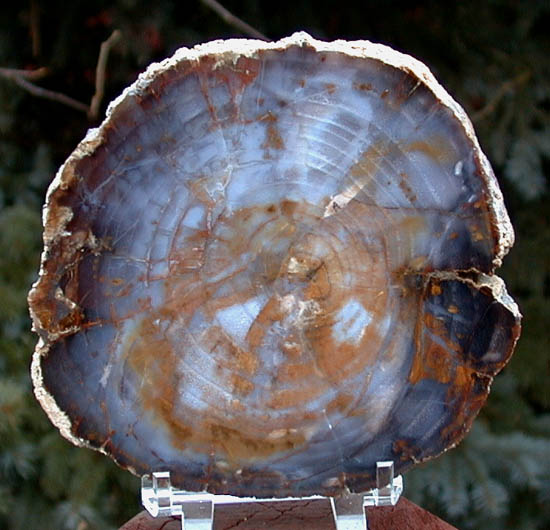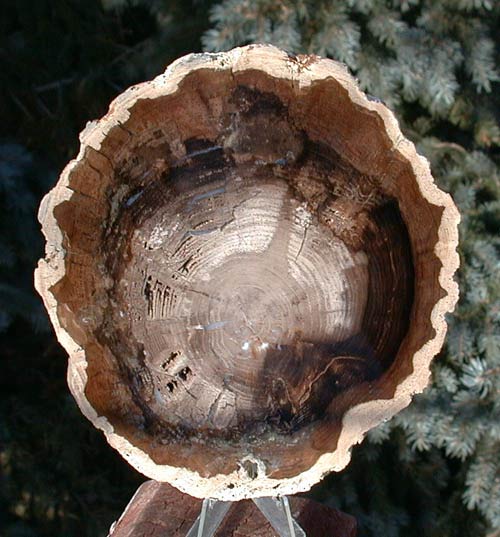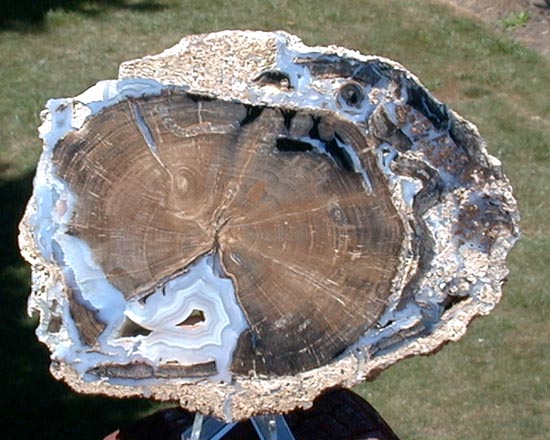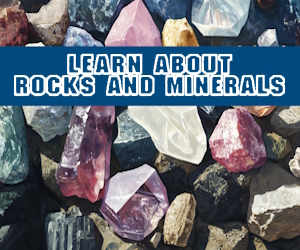English
Castellano
CatalÃ
Petrified wood and cones
Author: Jörg Scherber
Content by courtesy of : Jörg Scherber`s website

black ash
Grassey Mountain
Oregon
Why collecting petrified wood?
For my thesis I was looking for something special and that's how I felt in love with petrified wood. So I asked several people for some informations about petrified maple wood. Looking for such a piece I met Mr. Ulrich Dernbach from Heppenheim (a very well known German petrified wood dealer).After a short telephone call with Mr. Dernbach I got the chance to take a picture of a maple round. During taking the photo and looking through Mr. Dernbach`s collection it happened to me. From this moment I felt in love with the world of petrified wood. For 6 years now I´m collecting wood and my collection is still growing.
Thank´s to Mr. Dernbach for infecting me with the petrified wood virus!

white ash
McDermitt
Oregon
How does the wood petrify?
The wood must first be covered with such agents as volcanic ash, volcanic mud flows, sediments in lakes and swamps or material washed in by violent floods. By any means which would exclude oxygen (anaerobe) and thus prevent decay. A several number of mineral substances (such as Calcite, Pyrite, Marcasite) can cause petrification. By far the most common is silica. Solutions of silica dissolved in ground water infiltrate the buried wood and through a complex chemical process are precipitated and left in the individual plant cells. Here the silica may take a variety of forms: it may be agate, jasper, chalcedony or opal. The varied colors of petrified wood are caused by the presence of other minerals that enter the wood in solution with the silica. Iron oxides stain the wood orange, rust, red or yellow. Manganese oxides produce blues, blacks or purple.1. Wyoming
There are several petrified forests located at Wyoming. Three main collecting areas are well known.
a) the Big Sandy Reservoir located north of Farson
b) the region around Oregon Buttes
c) the legendary Blue Forest
Eden Valley petrified wood was formed from plants living about 58 million years ago (Eozän Geologic age). The rock exhibits features not found in fossil wood anywhere else in the world. The fossil wood is known for the light blue agate surrounding many of the pieces.
The petrification process for this area involved shallow “algae growing” lakes. In many cases for undetermined reasons the wood came to be in this water in its live condition before it had a chance to dry out. This wood became coated with algae which adhered to the surface making a cast or mold around the wood. Later the wood dried and shrunk in the mold made of algae. Over times these algae casts became part of a layered rock formation. Silicia-rich water solutions seeping through the rock then petrified the wood and filled in the spaces left between the dried wood and the hardened cast with blue agate, calcite and quarz.
As the agate coated the inside surface of the algae cast, perfect impressions of the bark were left in the agate. Because the petrification process seems to have been protected by the algae cast formation, unusually detailed representations of the wood have been preserved.
wood from the 'Blue Forest'
1. Blue Forest
(ca. 100 x 130 mm)
1.1 Palmoxylon
(ca. 90 x 100mm)
1.2 Blue Forest
(ca. 70 mm)

1.3 Blue Forest
(ca. 100 mm)
1.4 Blue Forest
(ca. 100 mm)
1.5 Blue Forest
(ca. 100 mm)
1.6 Blue Forest
(ca. 60 mm)
1.9 Blue Forest
(ca. 220 x 170 mm)

Information | Mineral photos | VIDEOS | Articles | Fairs | Web directory | Classified ads | Minerals Books | Shop






